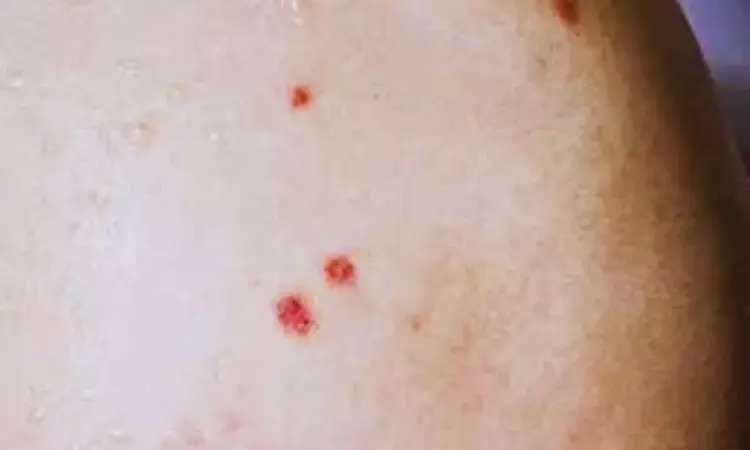- Home
- Medical news & Guidelines
- Anesthesiology
- Cardiology and CTVS
- Critical Care
- Dentistry
- Dermatology
- Diabetes and Endocrinology
- ENT
- Gastroenterology
- Medicine
- Nephrology
- Neurology
- Obstretics-Gynaecology
- Oncology
- Ophthalmology
- Orthopaedics
- Pediatrics-Neonatology
- Psychiatry
- Pulmonology
- Radiology
- Surgery
- Urology
- Laboratory Medicine
- Diet
- Nursing
- Paramedical
- Physiotherapy
- Health news
- Fact Check
- Bone Health Fact Check
- Brain Health Fact Check
- Cancer Related Fact Check
- Child Care Fact Check
- Dental and oral health fact check
- Diabetes and metabolic health fact check
- Diet and Nutrition Fact Check
- Eye and ENT Care Fact Check
- Fitness fact check
- Gut health fact check
- Heart health fact check
- Kidney health fact check
- Medical education fact check
- Men's health fact check
- Respiratory fact check
- Skin and hair care fact check
- Vaccine and Immunization fact check
- Women's health fact check
- AYUSH
- State News
- Andaman and Nicobar Islands
- Andhra Pradesh
- Arunachal Pradesh
- Assam
- Bihar
- Chandigarh
- Chattisgarh
- Dadra and Nagar Haveli
- Daman and Diu
- Delhi
- Goa
- Gujarat
- Haryana
- Himachal Pradesh
- Jammu & Kashmir
- Jharkhand
- Karnataka
- Kerala
- Ladakh
- Lakshadweep
- Madhya Pradesh
- Maharashtra
- Manipur
- Meghalaya
- Mizoram
- Nagaland
- Odisha
- Puducherry
- Punjab
- Rajasthan
- Sikkim
- Tamil Nadu
- Telangana
- Tripura
- Uttar Pradesh
- Uttrakhand
- West Bengal
- Medical Education
- Industry
High Uric Acid Levels Tied to Elevated Risk of Skin Cancer, Study Finds

China: A new study published in Clinical, Cosmetic and Investigational Dermatology has uncovered a significant association between elevated serum uric acid (SUA) levels and an increased risk of both malignant melanoma (MM) and non-melanoma skin cancer (NMSC). Conducted by Dr. Yihao Niu and colleagues from the Faculty of Chinese Medicine, Macau University of Science and Technology, the research utilized large-scale data from the National Health and Nutrition Examination Survey (NHANES). It employed Mendelian randomization techniques to evaluate causality.
Serum uric acid, a metabolic byproduct of purine breakdown, has previously been linked to various health conditions, including cardiovascular disease and metabolic syndrome. However, its role in skin cancer development has not been established. This study aimed to fill that gap by analyzing SUA levels with skin cancer incidence among 1,219 individuals—336 diagnosed with melanoma (MM) and 883 with non-melanoma skin cancer (NMSC)—from the NHANES dataset spanning 1999 to 2020.
Multivariable regression models were used to adjust for potential confounding factors, including age, sex, race, lifestyle habits, and existing comorbidities.
The following were the key findings of the study:
- Each 1 mg/dL increase in serum uric acid (SUA) was linked to a 19% higher risk of malignant melanoma.
- A similar rise in SUA was associated with a 13% higher risk of non-melanoma skin cancer.
- These associations were more evident among women and individuals of Mexican American ethnicity.
- Despite the observed associations, Mendelian randomization analysis did not confirm a causal relationship between SUA levels and skin cancer.
- Causality was assessed using methods like inverse variance weighting (IVW), MR-Egger, and the weighted median approach based on genome-wide association study (GWAS) data.
- The findings suggest that SUA may act as a risk marker rather than a direct cause of skin cancer.
- Restricted cubic spline (RCS) models revealed a non-linear relationship, with skin cancer risk increasing more sharply beyond certain SUA thresholds.
- Elevated SUA levels were more strongly linked to malignant melanoma risk in older adults (aged 60 and above).
- In contrast, non-melanoma skin cancer was found to be more prevalent in younger individuals with higher SUA levels.
The study’s authors emphasized the importance of interpreting SUA levels as part of a broader clinical picture, noting that systemic inflammation, oxidative stress, and immune dysregulation—all of which can be influenced by uric acid—may contribute to carcinogenesis.
The researchers note that while elevated SUA does not appear to be a direct cause of skin cancer, its strong association with MM and NMSC highlights its potential utility as a biomarker for identifying individuals at increased risk. They call for further investigations that integrate basic science, longitudinal data, and refined genetic tools to clarify the mechanisms at play and to explore whether lowering SUA might offer protective benefits.
Reference:
Niu Y, Shi S, Chen Y, Yang S, Yan P, Kou J. Association Between Serum Uric Acid Levels and Skin Cancer: Results from NHANES Data and Mendelian Randomization Analysis. Clin Cosmet Investig Dermatol. 2025;18:1437-1452 https://doi.org/10.2147/CCID.S517389
Dr Kamal Kant Kohli-MBBS, DTCD- a chest specialist with more than 30 years of practice and a flair for writing clinical articles, Dr Kamal Kant Kohli joined Medical Dialogues as a Chief Editor of Medical News. Besides writing articles, as an editor, he proofreads and verifies all the medical content published on Medical Dialogues including those coming from journals, studies,medical conferences,guidelines etc. Email: drkohli@medicaldialogues.in. Contact no. 011-43720751


